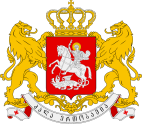Kingdom of Hereti
Kingdom of Hereti ჰერეთის სამეფო | |||||||
|---|---|---|---|---|---|---|---|
| 893–1020s | |||||||
King | | ||||||
| Historical era | Early Middle Ages | ||||||
• Established | 893 | ||||||
• Disestablished | 1020s | ||||||
| |||||||
| Today part of | Countries today | ||||||
| Part of a series on the |
| History of Georgia |
|---|
 |
The Kingdom of Hereti (
According to traditional accounts, the name of the province originated from the legendary patriarch "Heros", the son of Thargamos, who founded the city of Hereti (later known as Khoranta) at the Alazani River.
Background
From the earliest times, Hereti came under the rule of the
As a reward for the contribution in the struggle against the Arab occupation, the Iberian ruler (erismtavari) Archil gave Hereti to the noble family of Bagrationi in the 740s–750s. After the death of the last Iberian princes John and Juansher, the Heretian lords extended their fiefdoms and, in 787, established an independent principality (samtavro) with the capital in Shaki.
History
Its first recorded ruler,
Alarmed by the increasing power of the Heretian kingdom,

Ishkhanik was the son and successor of Adarnase Patrikios. Under Ishkhanik, Hereti was forced to recognize the supremacy of the stronger neighbour, Principality of Daylam, ruled by the Salarid dynasty. According to The Georgian Chronicles, Queen Dinar, during the reign of her son Ishkhani, converted Hereti to the Eastern Orthodox confession and abandoned the Oriental Orthodox confession in the 10th century. In 950, Ishkhanik took advantage of the bitter power struggle in the Sallarid state, and ceased to pay tribute effectively restoring his independence.
The next Heretian ruler, John (Ioane Senekerim, 951–959), during his reign kingdom of Hereti reached a climax of power and prestige, mainly after the annexation of the right bank of Caucasian Albania. Armenian historian Movses Kaghankatvatsi calls him "restorer of the Kingdom of Albania". Later he annexed parts of Kakheti and adopted the title of "King of the Tsanars". John had good relations towards the representatives of the Sallaried Dynasty and with David III Kuropalates of Tao. Like his father and his grandmother Queen Dinar, he contributed a lot to the conversion of his kingdom. He died in 959 without an heir.
The area then was contested between his successor,
rules.Rulers of Hereti
| Ruler | Reign | title | Notes |
|---|---|---|---|
| 1. Sahl Eṙanshahik | 815–840 | Prince | |
| 2. Adarnase (I)
|
840–865 | Prince | |
| 3. Grigol Hamam
|
865–897 | King | (since 893) |
| 4. Adarnase (II) | 897–943 | King | |
| 5. Ishkhanik | 943–c. 962 | King | |
| 6. John Senekerim | c. 965–995 | King | became "King of the Tsanars" |
| 7. Dinar | c. 1010s | Queen |
See also
References
Literature
- Papuashvili, T. Problems of Heretian history. Tbilisi, 1970. (in Georgian)
- Papuashvili, T. Kingdom of the Rans and Kakhs. Tbilisi, 1982. (in Georgian)
External links
- ყველაფერი ჰერეთის შესახებ Archived 2017-12-04 at the Wayback Machine (in Georgian)


